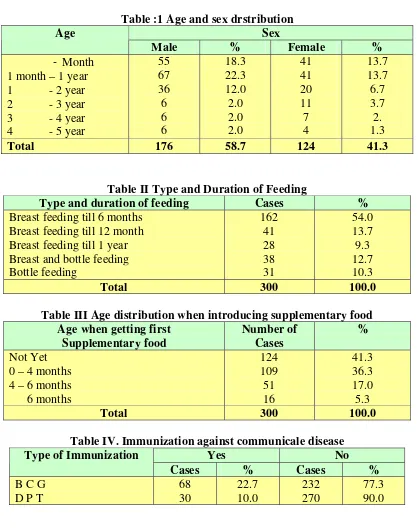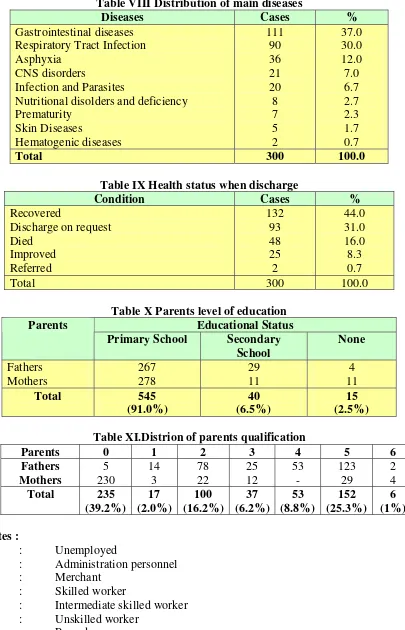Child Care Monitoring For A Better Child Health Service
Rajaidup Meliala S.M. Manoeroeng Chairuddin P. Lubis
Djaman Purba Jaminsen Sinaga
Helena Siregar
Child Health Dept. Medical School-University of North Sumatera/ Dr.Pirngadi General Hospital,Medan
Abstract
Three hundred under five years of age patients admitted to Dr.Pirngadi General Hospital Child Health Department during two months periode (October November 1981) were studiedt using child care monitoring form.
The age group with highest morbidity (86.7 %) was found in the age group of 0 - 2 year. Only 54.3% of the children got breast feeding until the age of 6 months. Supplemantary food was already given at the age of 0 - 4 months. Under nutrition was still high ( 41.7% ) particularly under the age of 2 years ( 32.7% ).
BCG and DPT immunization were still low respectively 22.7% and 10%. Gastrointestinal disease and Respiratory Tract Infection were the two leading diseases and Tetanus Neonatorum is also frequent.
The percentage of discharge on parents request was high ( 31 % ) which migt be related to low educational level of parents and low social economic condition.
Introduction
The Ministry of Health in achieving "Health for All by the Year 2000" had been actively in developing the Indonesian Health System and Program. Mother and Child Health as one of the main progress in the Primary Care is developed as a leading program. To meet this objective Medical Record standardization as a mean of data resources is absolutely needed. All Medical Centre in Indonesia should record its medical data uniformly which is very useful in evaluation and in making intervention program for the improvement of health services ( Ariawan,Soejoenoes, 1981 ).
Both Maternal Care Monitoring (MCM) and Child Care Monitoring (CCM) are a continoue system of data collecting which is very useful to develope mother and child health services ( Sambas Wiradisuria, 1981 ).
The success or failure of the program will also be reflected in these data. Base on these data a Health Officer is able to make improvement in the program for a better child health service.
The CCM model had been created AS questionaire form,known as RP2A (Registrasi Pencatatan Perawatan Anak) ( Ariawan Soejoenoes,1981).
In form RP2A there were 45 items in the questionaire which include data on parents and its siblings.
Material and Metode
During a two month periode ( October-November, 1981 ) there were 300 patients under five year of age admitted to Dr.Pirngadi General Hospital. In this study we excluded babies who were treated in the nursery rooms, who were normal term babies and patients who died before six hours of admission.
Data were collected by questionaire methode, using RP2A form. The patient's mother preferably were questioned by the doctors in charge but patient's fathers were also applied when the mothers were not available. These data collecting should be performed six hours after patients admission to the ward, for practical reasons-only.
If the data collected was incomplete home visits would be done later on. All collected data in RP2A were tabulated for further evaluation.
Results
The three hundreds under five years of age patients investigated consist of 176 males and 124 females. The highest morbidity among these patients was in the age group of 0-2 years which was 260 patients ( 86.7 % ). ( Table I ).
More than a half (54 %)of them got breast feeding until 6 months of age, but decreased very much when reaching the age of 12 months or move.
Breast feeding together with bottle feeding and bottle feeding alone were only in Small number respectively 12.7% and 10.3% ( Table II).
Supplemantary food given was already at the age of 0-4 months ( 36.3 %) and 22.3% get there after ( Table III ).
Only 22.7% were actively immunized against Tuberculosis (BCG) and 10% got DPT vaccine ( Table IV).
Darrheal diseases had been found 32 % of the patients with an avarage diarrheal episode more than three times a year for each age group ( Table V ).
Under nutrition (mild,moderate and severe malnutrition) were found in 41.7% of the patients, prevailing in the age group of 1 month to 2 years ( 2.7%) (Table V ).
Three Dinhteric patients were in the age group of 3-5 years while 7 (7O%) of the 10 Tetanus patients were Tetanus Neonatorum. Six cases (2%) of Measles patients were of the age group of 1-2 years. There was only one case of Tuberculosis (0,3%) (TableVII).
Gastrointestinal diseases were found in 37% cases and Respiratory Tract Infection in 307. (Table VIII). Both were leading diseases in this study.
Forty four percents of the patients went home with recovery 31% were discharged on parents reques and 16% died during treatment ( Table IX ).
Parents educational level were as follows: Primary -school 91%, secondary school 6.5% and 2.5% never had formal education ( Table X).
Most fathers were-unskilled or intermediate skilled worker (34.1%) and 39.2% were unemployed (Table XI ).
Discussion
particularly of protein for swiftly increasing muscle tissues (D.B.Jelliffe,1966). These age group are sensitive against nutritional deficiency (Kho et.al, 1975 ).
In this study we found the highest morbidity (86.7%) in the age group of 0-2 years. Parents ignorance of the importance of nutrition for the growth and development of a child will decrease body resistance of children.
In 1975, F.A.O. reported that infants who had breast feeding was decreased in Developing Countries. Early weaning will cause "infant malnutrition” and may have any, relationship with increase incidence of marasmus and diarrheal ,diseases ( Jelliffe, D.B, 1914 ).
Early weaning of breast feeding (till stx monthsof age) were found in more than half (54%) of our patients. This condition might be supportive to our finding of high diarrheal diseases.
Breast feeding should be advice till the age of two years and at the age of 5-6 months breast feeding should be added with supplemantary food (Suharyono,1977 ).
In our study early supplemantary food had been given in 36.3% patients namely in the age group of 0-4 months. Similar results had been reported by Manoeroeng, S.M. (1975 ). He found that weaning of breast feeding untill the age of 6 months was 71.3% and supplemantary food was already given at the age of 0-4 months (83%).
This study reported a low percentage of immunization such as BCG immunization in 22.7% and DPT in 10%. Similar results was also reported by Helena ( 1981 ) in her study in two villages in North Sumatra namely in Desa Perdagangan Seberang were only 29.9% children got BCG immunization and DPT 2.18%, and in Desa Tambunan were no child had ever BCG or DPT immunization (5,6). The Ministry of Health starget of immunization in 1980 was 40%-andiln 2000 80% (Hapsoro,1981).
All these findings were far below the target and very disappointing. Incidence of diarrheal diseases as reported by Ministry of Health in 1980 was 400/1000 population/year and hope in 2000 will decrease into 200/1000 population/year. Brotowasisto (1974) estimated the incidence of gastroenteritis in Developing Countries, 40-50/100 population/year of which 70%-80% occurs in under five years of age, particularly under the two years of age children.
This study recorded, more than 3 times/year attack of diarrheal diseases on each age group. Parents were particularly of low education and were mostly unskilled workers. We assumed that , the famillies in this study were ;from low social economic class. This low social economic condition T-eflected also the high incidence of malnutrition 41.7%, especially among the under 2 years of age (32.7%). It is already known that this younger age group were more sensitive against nutritional deficiency.
Among 10 patients who were suffering from Tetanus, 7 (70%) were Tetanus Neonatorum. Tetanus Neonatorum can be prevented or decreased by aseptic delivery and by active immunization of pregnant-women with Tetanus Toxoid. Eighty percents of delivery occur outside the Hospital handled by midwifes or traditional midwifes (Agoestina, 1981).
Patients discharge on parents request were still high ( 31% ). It might have relationship with low level parents education, Low social economic condition or other factors.
Further investigation and study on this attitude of the parents should be done and be great value.
References
Agoestina,T :Maternity Care Monitoring, Presented at The Third. Business Meeting of Social Pediatrics Working Group ( Indonesian Pediatrician Association) Bandung, 17 - 19 December 1981
Ariawan Soejoenoes : Beberapa Gagasan Penyusunan Program MCM untuk Tingkat Puskesmas dan Masyarakat (Pertolongan Persalinan Oleh Dukun)Presented at The Third:BusinessMeeting of Social Pediatrics Working Group ( Indonesian Pediatrician Association) Bandung, 17-19 Desember 1981
Hospital Medicine. Record System Procedure Manual page 1, 1975, Departemen Kesehatan. RI, Direktorat Jenderal Pelayanan Kesehatan Direktorat Rumah Sakit
Hapsoro : Pokok-Pokok Rencana Pembangunan Jangka Panjang Bidang Kesehatan, Presented at The Third Business Meeting of Social Pediareics Working Group ( Indonesian Pediatrician Association) Bandung, 17-19 Desember 1981
Helena Siregar : Penelitian Kesehatan Anakdi Desa Perdagangan Seberang. Lapuran Penelitian, ( 1981 )
Helena Siregar : Penelitian Kesehatan Anak di Desa Tambunan Kabupaten Langkat, Sumatera Utara .Lapuran Penelitian , ( 1981)
Jelliffe, D.B. : The Assessment of the Nutritional Status of the Community, World Health Organization, Geneva, (1966)
Kho, L.K.; Melani S and Syarif Rusli : Penyelidikan Pathogenese Beberapa Penyakit dengan Perdarahan pada Anak. MKI 5-6 : 634 ( 1975 ).
Manoeroeng S.M.; Panggabean A.M and Sembiring.L. : Tinjauan Terhadap Beberapa Kebiasaan Pemberian Makanan Tambahan Pada Anak Dibawah Umur Satu Tahun. Presented at KONIKA IV YogJakarta, ( 1978 )
Suharyono : Pandangan-Pandangan Terhadap Air Susu Ibu; Presented at BKGAI IV Parapat, ( 1977 )
Sunoto, Titut S Pusponegoro; Susilo Surachmad and W.R.Sanborn:treatment of Acute Infantile Gastroenteritis, Pede Ind.l7:351 - 360 ( 1977 ).
Table :1 Age and sex drstribution Sex
Table II Type and Duration of Feeding
Type and duration of feeding Cases %
Breast feeding till 6 months Breast feeding till 12 month Breast feeding till 1 year Breast and bottle feeding Bottle feeding
Table III Age distribution when introducing supplementary food Age when getting first
Supplementary food
Table IV. Immunization against communicale disease
Yes No
Type of Immunization
Table V. Age distribution of diarrheal attack during the last 12 months.
Table VI Distribution of Nutritional Status Nutritional Status Age
Good Mild/Moderate Severe
- Month
Table VII Age distribution of patients suffering from communiacle diseases Diseases
Age
None Diphteria Tetanus Mumps Tuberculbis Measles
Table VIII Distribution of main diseases
Diseases Cases %
Gastrointestinal diseases Respiratory Tract Infection Asphyxia
CNS disorders
Infection and Parasites
Nutritional disolders and deficiency Prematurity
Table IX Health status when discharge
Condition Cases %
Recovered
Discharge on request Died
Table X Parents level of education Educational Status Parents
Primary School Secondary School
Table XI.Distrion of parents qualification
Parents 0 1 2 3 4 5 6
1 : Administration personnel 2 : Merchant
3 : Skilled worker


